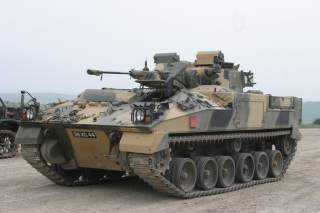Is Britain’s Infantry Fighting Vehicle Ready for 21st Century Warfare?
Or is it time to head to the scrap yard?
Britain’s FV510 Warrior IFV has never had a good record as an infantry fighting vehicle. While its protection and mobility are decent, the armament has long been maligned by analysts and its users. Compared to contemporary American and Soviet IFVs, the Warrior’s turret lacked any kind of FCS or stabilization. The 30mm gun was also clip-fed compared to the box or tray fed American and Soviet designs, limiting the practical rate of fire, making switching ammunition types difficult, and often causing jams.
The peace dividend delayed any upgrades to rectify these issues, and the performance of the Warrior during the GWOT was often considered “good enough.” Limited modernization occurred primarily with drop-in thermal sights and additional armor packages. But these upgrades didn’t address the primary issues with the Warrior’s turret.
Britain’s Ministry of Defense (MoD) started looking into modernizing the Warrior’s turret in 2009 with the Warrior Capability Sustainment Programme (WCSP), an in-depth modernization of the vehicle meant to keep it in service until the 2040s. Lockheed Martin UK and BAE Systems are the primary contractors competing in the programme. Competition continued until 2011 when the Lockheed Martin bid was officially selected by the MoD and was funded.
The final WCSP as selected consisted of multiple sub “programmes.” Warrior Fightability Lethality Improvement Programme (WFLIP) was the main one, the installation of a new turret with proper thermal sights, FCS, and new 40mm autocannon. Armor was also to be improved via the Warrior Modular Protection System (WMPS), which builds upon prior experience uparmoring Warriors during Operation Desert Storm and the GWOT to make a proper modular armor package, similar to that fitted to the German Puma. Finally, Warrior Enhanced Electrical Architecture (WEEA) would provide internal networking and power systems to tie all the new sensors and equipment together.
However, despite continued investment by the UK, the WCSP kept plodding along with continual delays and cost overruns. Not all of these can be attributed directly to the Lockheed Martin turret, as the design was reliant on many components made by other contractors that were not “ready” yet in 2011. For example, the CT40 cased-telescopic gun was not yet fully qualified and tested in 2011, and would only reach that stage around 2017.
In 2017, the first “production” WCSP Warrior rolled out of the factory, ready for trials. But again, the program suffered delays and overruns. Progress on the WCSP now is dictated by the performance of trial vehicles in what are called the Reliability Growth Trials (RGTs), evaluations of the capabilities of the vehicles on the Bovington proving grounds.
Recently, at DSEi 2019, it was announced that the WCSP trial vehicles were performing well at these RGTs and that a push for procurement of 280 WCSP modernized Warriors was likely to happen as there is no other plan for a modern British IFV.
On paper, the WCSP Warrior is a proper modern IFV, featuring a powerful main gun, good mobility, and modular armor. Unfortunately for the British Army, 280 WCSP Warriors is a rather small number compared to the original fleet of Warriors, which numbered over 700. But it squares with the modernization and downsizing of the rest of the force. The number of Challenger 2 MBTs in service is likely to see a similar reduction if recent upgrade programs are followed through on.
Charlie Gao studied Political and Computer Science at Grinnell College and is a frequent commentator on defense and national security issues.
Image: Wikimedia.

